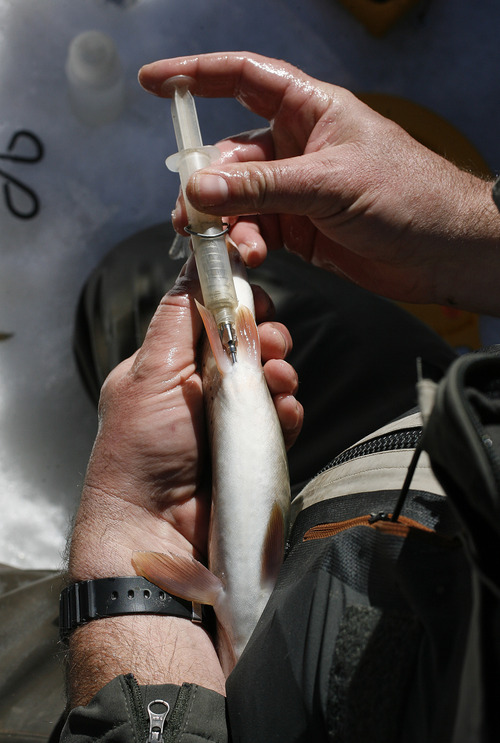This is an archived article that was published on sltrib.com in 2013, and information in the article may be outdated. It is provided only for personal research purposes and may not be reprinted.
Mountain Green • Paul Thompson admired the writhing native trout cradled in his big hands, pointing out a fin on its top side between the dorsal and caudal fins.
"He has the adipose fin so we haven't seen this fish before. When I clip the fin that tells us it's been tagged," said the biologist with the Utah Division of Wildlife Resources.
With a snip of scissors, the speckled fin fell to the snow, and Thompson inserted a syringe into the fish's belly to deliver a tiny tube-shaped chip. Now embedded in the Bonneville cutthroat trout is a unique 15-digit number that can be read by handheld scanners and flat-plate antennae installed in the beds of tributaries.
"No blood, no pain. He's just carrying a tag carrying information for us," said Thompson, DWR's northern region aquatics manager, releasing the fish into the Weber River's turbid waters Saturday.
The 12-inch cutthroat may not appreciate this strange handling, but it will help Utah biologists better understand the movement of native trout between the Weber and several tributaries near Mountain Green.
Various cutthroat subspecies have been pushed to the upper reaches of the river systems they inhabit around the West. But this alluvial population of Bonneville, first documented only a few years ago, still occupies a 10-mile stretch of the mother river. They are survivors that have persisted in a noisy canyon cluttered with an oil pipeline, irrigation diversions, a rail line and an interstate freeway.
These cutthroat, once written off on the Weber, migrate up some tributaries to spawn, but culverts and diversion walls pose formidable barriers, said Paul Burnett, a project coordinator with Trout Unlimited. On Saturday, the Weber Basin Anglers chapter recruited nearly two dozen members to help biologists by fishing this stretch of the Weber.
As the anglers landed cutthroat, Thompson and other DWR personnel recorded the length, weight and precise location of each, then injected tags in those that had not been previously caught.
Angler Scott Pickett, of Clinton, was pleased to help discover where these fish roam and further the conservation of a rare fish that officials hope to keep off the list of protected species.
"You can catch [non-native] brown trout all day long. It's fun, but when you lay into a 20-inch cutthroat, in this river that's a trophy," said Pickett. Two hours into the project, however, Pickett and his wife, Christie, were catching only mountain whitefish, prompting them to switch nymphs.
In the past two years, more than 1,000 Weber cutthroat have been fitted with PIT tags — an acronym for passive integrated transponder — which are similar to the microchips inserted in pets. This represents one-fourth to one-half of the resident population.
"We are getting amazing data," Thompson said. This spring, the team will monitor the tagged fish with a network of flat-plate antennae installed at the mouths of Strawberry, Jacobs, Gordon, Cottonwood and Peterson creeks. Biologists place the plates just below and above major obstacles. This arrangement allows biologists to determine which fish attempt to ascend the creek and which successfully get past the barrier.
DWR will use the data to guide where to invest limited resources for improved cutthroat habitat. Retrofitting culverts and irrigation diversions with fish-friendly features isn't cheap.
Burnett pointed to the 370-foot box culvert through which Strawberry Creek flows under Interstate 84. Its five-degree grade is designed to flush water and sediment, but it's a virtual wall for fish trying to swim up the creek to spawn. Trout Unlimited is sharing the cost with the Department of Transportation to reconstruct the 50-year-old culvert so fish can ascend one side over a series of steps and pools.

























